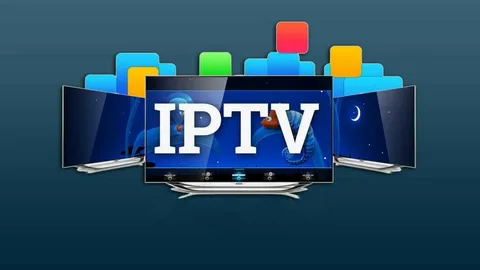Introduction: The Evolution of Television
Television, a cornerstone of modern entertainment and information dissemination, has undergone a remarkable transformation since its inception. From bulky cathode-ray tube sets displaying grainy black and white images to sleek, high-definition smart TVs, the way we consume visual content has been continuously evolving. This evolution has been largely driven by technological advancements, and one of the most significant recent developments is the rise of Internet Protocol Television, commonly known as IPTV.
What is IPTV? Decoding the Technology
At its core, IPTV represents a paradigm shift in how television content is delivered and consumed. Unlike traditional broadcasting methods that rely on terrestrial antennas, satellite dishes, or coaxial cables to transmit signals, IPTV leverages the internet protocol (IP) – the same technology that underpins the World Wide Web – to deliver television programs and video-on-demand (VOD) content directly to viewers.
Think of it this way: instead of receiving a continuous stream of all available channels, with IPTV, you request specific content, and that content is then streamed to your device over your internet connection. This on-demand nature is one of the key differentiators and advantages of IPTV.
How Does IPTV Work? The Technical Underpinnings
The process of delivering television content via IPTV involves several key stages:
- Content Acquisition and Encoding: Broadcasters and content providers first acquire or create television programs and movies. This content is then digitally encoded into various formats suitable for transmission over the internet. Encoding involves compressing the video and audio data to reduce bandwidth requirements without significantly compromising quality.
- Content Delivery Network (CDN): Encoded content is typically stored on a network of servers strategically located across geographical regions. This Content Delivery Network (CDN) ensures that content can be efficiently delivered to users regardless of their location, minimizing latency and buffering.
- IP Network Transmission: When a user selects a channel or VOD content through their IPTV service, a request is sent over the internet to the CDN server closest to them. The server then streams the requested content as data packets using the internet protocol.
- User Device and Decoding: On the user’s end, a compatible device – such as a smart TV with built-in IPTV capabilities, a set-top box connected to a regular TV, a computer, a tablet, or a smartphone – receives these data packets. The device then decodes the data, converting it back into viewable video and audible sound.
Key Advantages of IPTV: Why It’s Gaining Popularity
IPTV offers a multitude of benefits that have contributed to its growing popularity among consumers worldwide:
- On-Demand Content and Time-Shifting: One of the most significant advantages is the ability to access a vast library of on-demand content, allowing viewers to watch what they want, when they want. Features like pause, rewind, and fast-forward provide unprecedented control over the viewing experience. Catch-up TV services, which allow viewers to watch previously aired programs, further enhance this flexibility.
- Personalized Viewing Experience: IPTV platforms can offer personalized recommendations based on viewing history and preferences. This allows users to discover new content tailored to their interests, enhancing engagement and satisfaction.
- Interactive Features: Unlike traditional television, IPTV enables interactive features such as electronic program guides (EPGs) with detailed program information, interactive polls and quizzes, and even the potential for integrated social media interaction.
- Integration with Other Services: IPTV can be easily integrated with other internet-based services, such as video conferencing, online gaming, and web browsing, often through a single device or platform.
- Potential for Higher Quality: With sufficient bandwidth, IPTV can deliver high-definition (HD) and even ultra-high-definition (UHD) content with superior picture and sound quality compared to some traditional broadcasting methods.
- Cost-Effectiveness (Potentially): Depending on the service provider and the bundled offerings, IPTV can sometimes be a more cost-effective alternative to traditional cable or satellite subscriptions, especially for users who primarily watch specific channels or on-demand content.
- Portability and Accessibility: IPTV services can often be accessed on multiple devices and across different locations (within the service provider’s geographical limitations), offering greater flexibility and convenience.
Potential Challenges and Considerations
While IPTV offers numerous advantages, there are also some challenges and considerations to be aware of:
- Internet Dependency: A stable and sufficiently fast internet connection is crucial for a seamless IPTV viewing experience. Buffering, interruptions, and reduced picture quality can occur with slow or unreliable internet.
- Bandwidth Requirements: High-definition and especially ultra-high-definition IPTV streaming consume significant bandwidth. Users with limited data plans or slow internet speeds may incur additional costs or experience performance issues.
- Service Reliability: The reliability of IPTV services depends heavily on the infrastructure and maintenance of the service provider. Outages or technical issues on their end can disrupt the viewing experience.
- Content Availability and Licensing: The availability of specific channels and content can vary depending on the IPTV service provider and the licensing agreements they have in place.
- Security Concerns: Like any internet-based service, IPTV is susceptible to security risks such as data breaches and unauthorized access. Users should ensure they are using reputable and secure IPTV providers.
- Fragmentation of the Market: The IPTV market can be fragmented, with numerous providers offering different packages, features, and content. This can make it challenging for consumers to choose the best option for their needs.
The Future of IPTV: Trends and Innovations
The future of IPTV looks promising, with several key trends and innovations shaping its evolution:
- Further Integration with Streaming Services: The lines between traditional IPTV and online streaming services are becoming increasingly blurred. Many IPTV providers are integrating popular streaming apps and offering bundled subscriptions to provide a more comprehensive entertainment experience.
- Enhanced Personalization and Artificial Intelligence (AI): AI-powered recommendation engines will become even more sophisticated, offering highly personalized content suggestions and potentially even tailoring the viewing experience based on individual preferences and viewing habits.
- Interactive and Immersive Experiences: We can expect to see more interactive features, such as augmented reality (AR) overlays and interactive advertising, integrated into IPTV content. The potential for immersive experiences, such as virtual reality (VR) integration, is also being explored.
- Cloud-Based DVR and Storage: Cloud-based digital video recording (DVR) services will become more prevalent, allowing users to record and access their favorite programs from any device without the need for local storage.
- Improved Video and Audio Quality: As internet speeds continue to increase and compression technologies advance, IPTV will be able to deliver even higher quality video and audio, including 8K resolution and immersive sound formats.
- The Rise of Niche and Specialized IPTV Services: We are seeing a growth in IPTV services catering to specific interests and demographics, offering niche content that may not be readily available through traditional broadcasting.
Conclusion: IPTV as a Dominant Force in Television
IPTV has emerged as a transformative force in the television landscape, offering viewers greater flexibility, control, and personalization than traditional broadcasting methods. While challenges such as internet dependency and bandwidth requirements exist, the numerous advantages and ongoing innovations position IPTV as a dominant mode of television consumption in the digital age. As technology continues to evolve, IPTV will undoubtedly play an even more significant role in how we access and experience visual content, offering a richer and more interactive television experience for viewers worldwide. For a reliable and comprehensive IPTV experience, consider exploring options like IPTV .







